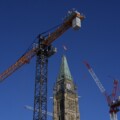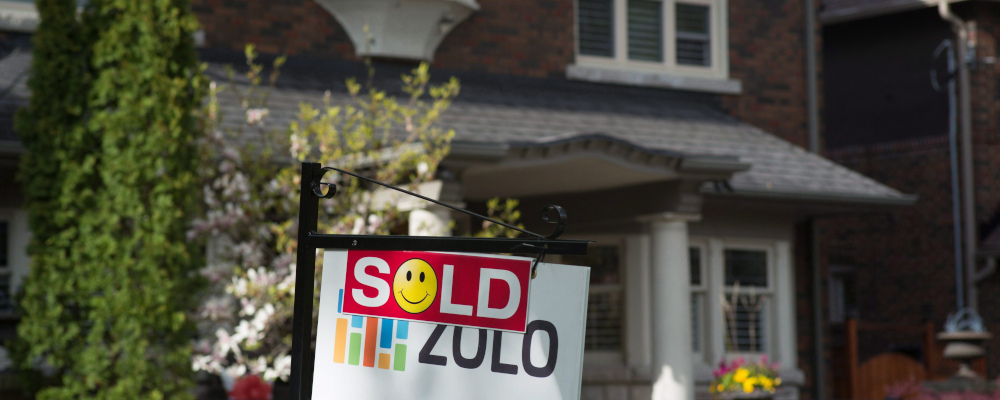The important questions of politics rarely change, we just change the way we talk about them.
Consider housing prices: in the 1970s, politicians understood that the problem was, at its most basic level, one of supply and demand. Today, it seems we only ever hear about inadequate supply. Politicians talk about the need for more houses, but they’ve stopped talking about why we need them. What happened to demand?
With starter homes in Vancouver and Toronto selling for 14 times the average income, the concern is especially acute right now, but it’s not new. In 1976, economist Gordon Soules interviewed two young Vancouver politicians for a book on rising house prices. See if you can guess who they are:
Concerned Politician 1: “First, it is essential that we relate both the local and the national housing problems to our immigration laws. Are we in fact merely trying to create new housing, as well as new employment opportunities, just to keep pace with the yearly average of 200,000 immigrants that Canada is admitting every year?”
Concerned Politician 2: “Foreign investors, many speculatively, are driving up home prices beyond the reach of British Columbians,” and in an “ideal” world “most land would be owned by the government and leased to the people.”
Surprisingly, the first quote was from Mike Harcourt, the future mayor of Vancouver and NDP premier; the second, promoting socialized real estate, was from future Social Credit premier Bill Vander Zalm. Even more surprising, there was consensus across political lines that immigration policy was a factor in rising housing prices. Vancouver’s progressive mayor Art Phillips chimed in, telling Soules: “I maintain that the primary approach to solving the housing problem in the Greater Vancouver area lies in the immediate reduction and future control of immigration.”
Sometime between then and now, we forgot about the demand side of that most basic of economic equations. In the meantime, Vancouver has added 1.5 million new residents, and house prices keep climbing. That doesn’t mean that there aren’t other factors involved.
Construction fees, zoning rules, social housing policies, regulations, and commodity prices have all played a part, as have internal migration and federal monetary policy, but it’s magical thinking to imagine that doubling the city’s population hasn’t been a major factor.
The air of unreality extends to federal politics. At the same time economists are warning us about an over-inflated housing market, and the Governor of the Bank of Canada is worrying openly that “recent rapid increases in home prices are not normal,” the federal government is planning an historically large surge in immigration.
For most of the last decade, the federal government under both Conservatives and Liberals admitted an average of 275,000 new permanent residents to Canada each year, and about twice that number of temporary residents. Now, against consistent public opinion, the Liberals are promising to raise the number to more than 420,000. That is the equivalent of adding a new Halifax every year, or a new Alberta over the next decade.
Except, of course, that with most newcomers gravitating to the largest cities, it really means more demand in the places that already have the most expensive housing markets.
At some point, we forgot about the demand side of that most basic of economic equations.
It doesn’t have to be this way. Immigration levels are not a force of nature beyond our control. Each year, the federal minister of immigration tables a “levels plan” in parliament announcing the total number of permanent residents his ministry will process that year. There is hardly any policy discussion about the optimal level inside government, and even less outside.
Considerations like housing or infrastructure or health care don’t enter into it. In its 41-page immigration levels plan for 2020, the Trudeau government didn’t mention either of these issues. Nor did it note, let alone discuss, the environmental and ecological impact of moving so many people to the one of the most carbon intensive countries in the world — a concern that once led David Suzuki to declare that “Canada is full.”
A new Public Policy Forum report by the economist and former head of the B.C. public service, Don Wright, corrects these blind spots. The report offers several ways the federal government can raise the Canadian middle-class standard of living, including by shifting “from immigration policy that is focused merely on increasing GDP to one focused on increasing GDP per capita” and by reversing the downward pressure on Canadian wages and the rising pressure on housing caused, in part, by current levels.
The report’s discussion begins, as all such discussions invariably do in Canada, with the assurance, in so many words, that the author is not Donald Trump. In a country that took public policy seriously this disclaimer wouldn’t be necessary, but this is Canada where, as Wright accurately observes, “the promoters of large immigration numbers are quick to label as racist, parochial or small-minded any questioning of larger immigration numbers.”
The accusations are nonsensical, of course. Justin Trudeau’s immigration policy in 2016 wasn’t racist because the annual level was lower than it is today, nor is the current level xenophobic because next year it will be even higher. And when Pierre Trudeau cut annual immigration in half between 1967 and 1972 and then by 60 percent between 1974 and 1978, he wasn’t being “parochial or small-minded,” it was just part of the normal fluctuations in immigration levels that used to track economic and political conditions.
Wright believes that “the optimal level of immigration” is not only “a legitimate question of public policy debate,” but it should offer “a much more nuanced set of policy ideas than ‘more people mean a bigger GDP.’”
It should, for example, include discussion of things like “GDP per capita and how income is distributed” — things that matter because they directly affect our quality of life. Things like the cost of housing, which is the single largest expense for Canadian families and determines how long they have to climb the property ladder before they can afford to settle somewhere and help build the neighbourhood relationships that are so important for personal happiness and the communities that are necessary for social solidarity.
It won’t come as a surprise to residents in Vancouver and Toronto, but it is still shocking to read that their cities are, according to a study by Demographia cited by Wright, “more unaffordable than any American city.” Of Canadian cities, Vancouver, Toronto, Montreal, and Ottawa fall into the study’s worst category of “severely unaffordable,” while Calgary is “seriously unaffordable” and the homes of lucky Edmontonians are “only moderately unaffordable.”
According to Wright, “[t]here are multiple reasons why Canada’s housing has become so unaffordable, but it defies credulity to argue that high levels of immigration will not exacerbate the growing unaffordability of housing in Canada.” This is because “[i]mmigration levels of between 400,000 and 425,000 per year (the current target of the federal government) means an additional demand for approximately 170,000 new homes each year.” And, of course, “[c]lose to 75 percent of immigrants settle in these six major cities.” Supply, meet demand.
Nowhere is it written that Canada’s population must increase, year on year, forever.
In response to sluggish real wages and rising housing prices, Wright commits Laurentian blasphemy and wonders “[c]ould it not be better in the near term to lower the level of immigration, while significantly improving support to new immigrants, giving them a better chance to more easily integrate into the economic mainstream?” He doesn’t get into specific numbers, but it is remarkable enough that he even asks the question.
Wright’s proposal is modest, the kind of plan that would have received broad bipartisan support in Canada until quite recently, and still would in most of our peer countries. It wasn’t long ago that respected figures on the left like Bernie Sanders denounced high levels of immigration as serving the interests of big business rather than domestic workers, and in 2017 progressive darling Jacinda Ardern ran on a platform of cutting immigration to New Zealand by up to 40 percent, in part to address housing pressures. (She didn’t keep her promise, but her government is once again talking about reforming post-Covid migration policy to relieve the pressure on housing, infrastructure, and the environment.)
An even more ambitious plan, one that would tackle the housing crisis head on, would aim explicitly for population stability.
Nowhere is it written that Canada’s population must increase, year on year, forever. It isn’t ordained in the constitution that Toronto and Vancouver must absorb hundreds of thousands of newcomers every year, or that their downtowns must bristle with cranes and condo towers and their suburbs sprawl a little further each year up the mountainsides, along the lakeshore, and into surrounding farmland and greenbelts. Relentless urban growth is the result of political decisions made each year in Ottawa. It is a choice, but it isn’t the only choice.
In two articles, from 2012 and 2017, Anatole Romaniuk, the former director of the Demographic Division at Statistics Canada, offered his vision of what a stable population would look like and how it would work.
Romaniuk begins by challenging the assumptions of “the populationist agenda which postulates that growing and large populations are the forces that move economies forward and project a nation’s international might.” Chasing “relevance” — one of the undefined goals of the Trudeau government’s Century Initiative — is a mug’s game. We will never come close to matching the populations of China and India and our international reputation has never have been based on our population. Besides, the government’s job is to boost domestic quality of life, not diplomats’ egos or the interests of the bankers and global management consultants advising it.
Like Wright, Romaniuk takes pains to establish that his proposal is not anti-immigration per se and certainly not anti-immigrant. Romaniuk, an immigrant himself, believes that “[a] liberal society by its very nature cannot be a closed society” and “[w]hile immigration is not a solution to all our social and economic problems, it can be a part of it.” He simply wants us to consider, probably for the first time in a generation, what is it we want immigration to do, and then design a policy to achieve it. In other words, he wants us to think of immigration policy as policy, the same way we think about taxes or research funding, rather than as a feel-good commitment without real-world effects.
Romaniuk runs through the data, well-known to most demographers and immigration experts but rarely acknowledged by our politicians and pundits, deflating the commonly assumed benefits of our current high — and the even higher proposed — annual immigration levels.
For example, multiple studies have showed that there is little, if any, link between increasing immigration and per capita GDP growth; that the earning gap between new immigrants and the Canadian-born has persisted or widened since 1980; that the poverty level of new immigrants is more than twice that of the Canadian-born (and has almost certainly gotten worse during the pandemic); and, contrary to the most popular justification — keeping our pension Ponzi scheme afloat — it has only a modest impact on population aging (according to StatCan, even the high assumption on immigration levels would only lower our average age by one year by 2036).
This is the sort of stubborn data that our politicians either ignore or dismiss in favour of inspirational stories of individual success, but which no amount of wishful optimism can refute.
Reviewing Romaniuk’s 2017 article, Dr. Roderic Beaujot of Western University suggests that it would be possible to stabilize our population through a mix of slightly higher birthrates and slightly lower, but still not insubstantial, annual immigration: specifically, “a cohort fertility of about 1.7 and a net annual immigration of about 0.6 per cent [would] produce about zero population growth in the long run.”
Such a policy would only require us to reduce permanent immigration to 225,000 a year — about the number of the late Chrétien years and still much higher than the G7 average — and would draw on recent pro-family policy proposals to modestly increase the Canadian birthrate to about where it was in 2010, or where it is now in the United States. It may even be that, by cooling the demand for housing, and thereby removing one of the reasons young Canadians often cite for putting off starting or having families, lowering immigration might itself play a small part in increasing birthrates.
Population stability alone wouldn’t solve the housing crisis. There would still be a need for some of the supply-side solutions that have been proposed, such as zoning for fewer detached houses, more infills, shared living spaces, and clearing away regulatory barriers to allow us to just build more, more, more, anywhere and everywhere.
But a future of denser, taller, more crowded, and smaller living units isn’t everyone’s idea of an affordable housing solution. So, as we work on the perennial problem of supply, perhaps we can remember a time, not long ago, when politicians talked seriously about the demand side of the equation as well.
Recommended for You

‘A celebration of the spirit of Alberta’: Ryan Hastman on the political, economic, and cultural importance of the Calgary Stampede

‘Can we actually be an independent country?’: Michael Ignatieff on the 60th anniversary of Lament for a Nation

Fred DeLorey: Why the NDP may be in even bigger trouble than we think

DeepDive: Canada desperately needs its own Department of Government Efficiency—but one with a heart




